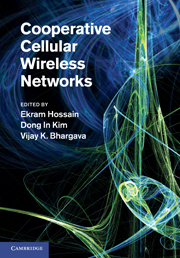Book contents
- Frontmatter
- Contents
- List of contributors
- Preface
- Part I Introduction
- Part II Cooperative base station techniques
- 3 Cooperative base station techniques for cellular wireless networks
- 4 Turbo base stations
- 5 Antenna architectures for network MIMO
- Part III Relay-based cooperative cellular wireless networks
- Part IV Game theoretic models for cooperative cellular wireless networks
- Part V Standardization activities
- Index
3 - Cooperative base station techniques for cellular wireless networks
from Part II - Cooperative base station techniques
Published online by Cambridge University Press: 03 May 2011
- Frontmatter
- Contents
- List of contributors
- Preface
- Part I Introduction
- Part II Cooperative base station techniques
- 3 Cooperative base station techniques for cellular wireless networks
- 4 Turbo base stations
- 5 Antenna architectures for network MIMO
- Part III Relay-based cooperative cellular wireless networks
- Part IV Game theoretic models for cooperative cellular wireless networks
- Part V Standardization activities
- Index
Summary
Introduction
The spectral efficiency of existing cellular networks is limited by interference. In cellular mobile networks, the dominant interference comes from adjacent cells. This is especially true when the users are located near the cell edges where the interference from the adjacent cells is very strong. By getting the adjacent base stations (BS) to cooperate, spatial antenna diversity in each BS can be utilized to cancel the interference. To obtain BS cooperation, multiple BSs share information about the transmitted messages to their respective users and wireless channels via a backbone network. Each BS can transmit either a single symbol stream or multiple symbol streams to its respective mobile station (MS). Individual BSs and MSs are equipped with multiple transmit and receive antennas, respectively. Each BS transmitter uses the transmitted signal information from other BSs and wireless channel conditions to precode its own signal. The precoded signal for each BS is broadcast through all BS transmit antennas in the same frequency band and time slots. The precoding operation and transmit receive antenna coefficients are chosen in such a way as to minimize the interference coming from other BS transmissions. The calculated receive antenna coefficients are then sent from the transmitter to the receiver through a wireless channel prior to the data transmission. In this chapter, we consider the use of a cooperative BS system to eliminate the interference in cellular networks.
- Type
- Chapter
- Information
- Cooperative Cellular Wireless Networks , pp. 47 - 76Publisher: Cambridge University PressPrint publication year: 2011



